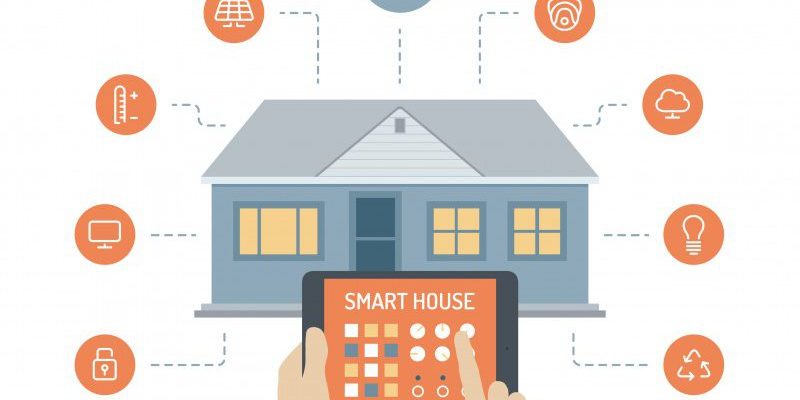Is a Smart Home a Smart Choice for Energy Efficiency?
“Smart” seems to have become a popular buzz word these days as more and more companies are attempting to dip their toes into the growing smart game. So what is a smart device? That can be tricky to define for some people since so many smart devices do such different things, but a smart device can be described as one that is able to connect and interact with its user and other smart devices. Nearly everyone seems to have one smart device: the mobile phone. That device can be the first brick in building a smart – and more energy efficient – home.
So how can your smartphone make your home more energy efficient? Think of the phone as a master remote control capable of controlling through a wireless Internet connection many different things in the home, but it’s not encumbered by walls and distance the same way your TV’s remote is. While there are many smart devices out there, this will only be looking at those devices that can help you save some money on your electricity bill.
Smart Thermostat
Cooling and heating the home traditionally make up the largest portion of the monthly electricity bill, so finding ways to better control your air conditioner will ultimately lead to more savings. A smart thermostat is much like a traditional thermostat but has many extra features.
The main purpose of a smart thermostat is to read and maintain the temperature in your home, but the real power in a smart thermostat is in its customization. Users can take control of how they want temperature settings at any time. You can schedule the thermostat to a warmer temperature when you are away from work and already have the AC cooling the home before you walk in the door. All this would take is setting up a schedule.
Does all that scheduling sound like a lot of work? There are now smart thermostats that can be linked to a smartphone’s location. When the thermostat notices that the registered smartphone is away from the home, the thermostat will adjust to a warmer temperature that you programmed and then start cooling automatically upon your return. Instead of tracking a phone’s location, sensors can be added to work alongside the thermostat. When no people are detected through the sensors, the thermostat will enter its away state.
And if none of those solutions seems to work for you, there is always the app for your phone. The app is capable of controlling the thermostat as well, and may allow users to adjust the thermostat through WiFi wherever that person is. Did you go on vacation and forget to adjust the thermostat? Just use the app to change the thermostat’s temperature, no matter the miles.
Smart Lighting
After heating/cooling, lighting tends to be the next biggest user of electricity, so let’s try to find ways to bring that usage down.
These smart LED bulbs connect to your system, usually via WiFi or Bluetooth. From there, the customization is up to you. Aside from turning the lights on or off from your phone, you can schedule the lights to turn on or off at particular times. You can use your phone to set the exact brightness that you want, the exact color of light. Some of these smart bulbs come with a multicolor option that boasts millions of colors. The apps available for these bulbs allow you to set up groups of lights. That means you can group the four lights on the ceiling fan in your living room. You can control the lights in that group all at once or individualize each one.
Like the smart thermostat, many of these lights can be controlled anywhere from your phone. Ever been at work and thought maybe you left the lights on? Now you could potentially turn the lights off from miles away, depending on the type of smart bulb.
These smart LED bulbs do tend to be more expensive; all of that functionality and connectivity comes at a price. The multicolor bulbs, in particular, run more expensive, but if all you want is just regular white light, you can save a lot of money because the white bulbs are much less expensive than the multicolor.
Smart Plug
Whether you’re home or not, whether it’s even turned on or not, your TV, your DVR, your computer are all using a little bit of electricity. Basically, anything that’s plugged in is taking a little bit of energy. That’s often called vampire energy or vampire power. Appliances and electronics are another prime users of electricity, and the smart plug can help users put a stake in the heart of vampire power.
Smart plugs allow you to control if any energy is used. Users can turn off the power being sent through the smart plug and then simply use an app on the phone to allow power to go through it again. Most also feature scheduling capabilities similar to the smart thermostat and smart lights.
It’s really easy to install a smart plug as well. They simply go into an existing wall socket and then need to be connected to the Internet.
Smart Light Switch
For those who don’t want to upgrade all of your lights to smart lights, this could be a good alternative. Similar to the smart plug, this would replace your existing light switch with the replacement featuring scheduling options as well as on/off functionality. Many of these switches also come with dimming capabilities, which can also be an easy method for saving energy.
Conclusions
If you haven’t considered any smart devices, it’s a good time to consider dipping your toe into that pool. While there were few options in some of these product categories just a few short years ago, now there are many companies entering the smart market and trying to make consumers’ lives a little easier. That means that prices have started to drop, especially on lighting, but that also means that buyers might have to do a little bit more homework before making a purchase.
More choices mean sometimes wildly different functionality. Some devices might use a hub to connect while others use WiFi or Bluetooth. Some might be restricted to only functioning within a certain distance while others will allow you to control from anywhere. Each of these devices also will come with its own app, and some of those apps might be more user-friendly than others.
The biggest downside to smart devices is that they aren’t very smart when there is no Internet connection. Keep in mind that the apps won’t be able to communicate with their respective devices without some type of signal.
But if you are really serious about trying to reduce your energy consumption and start saving a little bit on your electricity bill, smart devices are a powerful tool for customers. With a little effort, they offer all kinds of customization and allow users to take greater control of their energy footprint.

